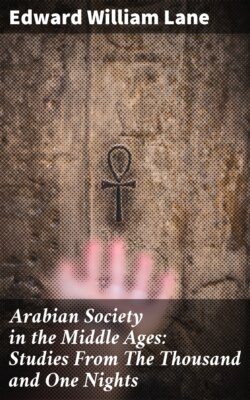Читать книгу Arabian Society in the Middle Ages: Studies From The Thousand and One Nights - Edward William Lane - Страница 10
FOOTNOTES:
Оглавление[18] Mir-át ez-Zemán (MS. in my possession)—a great history whose author lived in the thirteenth century of our era. See also Ḳur. v. 65.
[19] Mir-át ez-Zemán. Ḳur. lv. 14. The word which signifies "a smokeless fire" has been misunderstood by some as meaning "the flame of fire:" El-Jóheree (in the Ṣiḥáḥ) renders it rightly; and says that of this fire was the Sheyṭán (Iblees) created.
[20] Ḳur. xv. 27; and Commentary of the Jeláleyn.
[21] Ḳur. xxvii. 10; and xxviii. 31; and the Jeláleyn.
[22] Ḳur. lv. 39, 74; and the Jeláleyn.
[23] ´Ikrimeh, from Ibn-´Abbás, in the Mir-át ez-Zemán.
[24] Mujáhid, from the same, ibid.
[25] Hence the appellations of "Jinn" and "Jánn."
[26] Tradition from the Prophet, in the Mir-át ez-Zemán.
[27] Ibid.
[28] The worship here spoken of is prostration, as an act of obeisance to a superior being.
[29] Ḳur. xviii. 48.
[30] Eṭ-Ṭabaree, quoted in the Mir-át ez-Zemán.
[31] Mir-át ez-Zemán.
[32] Ḳur. vii. 11; and xxxviii. 77.
[33] Mir-át ez-Zemán.
[34] El-Ḥasan El-Baṣree, in the Mir-át ez-Zemán. My interpolation of the word "other" is required by his opinion before stated.
[35] Mujáhid, quoted by El-Ḳazweenee.
[36] Mujáhid, from Ibn-´Abbás, in the Mir-át ez-Zemán.
[37] El-Ḥasan El-Baṣree, ibid.
[38] ´Ikrimeh, from Ibn-´Abbás, ibid.
[39] Mishkát el-Maṣábeeḥ, ii. 314.
[39a] Ibid. ii. 311, 312.
[40] Mir-át ez-Zemán. See above, p. 18.
[41] Modern Egyptians, ch. x.
[42] Ibid.
[43] Sale, in a note on chap. xv. of the Ḳur-án.
[44] So I translate the word "khaṭṭ;" but in Es-Suyooṭee's Nuzhet el-Mutaämmil wa-Murshid el-Mutaähhil, section 7, I find, in its place, the word "weshm," or "tattooing;" and there are some other slight variations and omissions in this tradition as there quoted.
[45] El-Ḳazweenee.
[46] Ḳur. lxxii. 6.
[47] Modern Egyptians, ch. x.
[48] Ibid. ch. xxiv.
[49] Ḳur. xxvii. 17; xxxviii. 35.
[50] Modern Egyptians, ch. x.
[51] Ibid.
[52] El-Ḳazweenee.
[53] El-Jáḥiz (´Amr Ibn-Baḥr).
[54] Tradition from Wahb Ibn-Munebbih, quoted in the account of the early Arabs in the Mir-át ez-Zemán.
[55] El-Ḳazweenee.
[56] Ibn-El-Wardee [fourteenth century].
[57] Its name is written differently in two different MSS. in my possession.
[58] El-Ḳazweenee, and Mir-át ez-Zemán.
[59] El-Ḳazweenee. In my MS. of Ibn-El-Wardee, I find the name written "Dahlán." He mentions an island called by this name, in the Sea of ´Omán; and describes its inhabitants as cannibal Sheyṭáns, like men in form, and riding on birds resembling ostriches. There is also an inferior class of the Jinn, termed El-Ghowwáṣah, that is, the Divers or Plungers in the seas.
[60] El-Ḳazweenee, in the khátimeh [or epilogue] of his work.
[61] Mir-át ez-Zemán.
[62] Ibn-El-Wardee.
[63] Idem.
